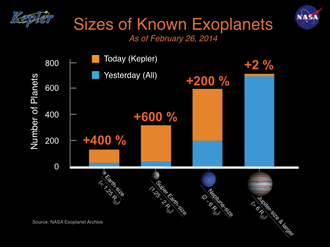
Back اكتشاف الكواكب الخارجية Arabic Chronologie des découvertes d'exoplanètes French Penemuan eksoplanet ID История обнаружения экзопланет Russian



An exoplanet (extrasolar planet) is a planet located outside the Solar System. The first evidence of an exoplanet was noted as early as 1917, but was not recognized as such until 2016; no planet discovery has yet come from that evidence.[2] What turned out to be the first detection of an exoplanet was published among a list of possible candidates in 1988, though not confirmed until 2003. The first confirmed detection came in 1992, with the discovery of terrestrial-mass planets orbiting the pulsar PSR B1257+12.[3] The first confirmation of an exoplanet orbiting a main-sequence star was made in 1995, when a giant planet was found in a four-day orbit around the nearby star 51 Pegasi. Some exoplanets have been imaged directly by telescopes, but the vast majority have been detected through indirect methods, such as the transit method and the radial-velocity method. As of 1 June 2024, there are 5,742 confirmed exoplanets in 4,237 planetary systems, with 904 systems having more than one planet.[4] This is a list of the most notable discoveries.
- ^ Cofield, Calla. "Cosmic Milestone: NASA Confirms 5,000 Exoplanets". NASA Jet Propulsion Laboratory (JPL). Retrieved 2022-03-25.
- ^ Landau, Elizabeth (12 November 2017). "Overlooked Treasure: The First Evidence of Exoplanets". NASA. Retrieved 1 November 2017.
- ^ Cite error: The named reference
Wolszczanwas invoked but never defined (see the help page). - ^ Schneider, J. "Interactive Extra-solar Planets Catalog". The Extrasolar Planets Encyclopedia. Retrieved 1 June 2024.
© MMXXIII Rich X Search. We shall prevail. All rights reserved. Rich X Search